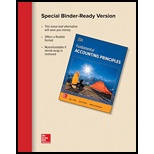
Concept Introduction:
Acid- test ratio: It is also known as the
To Determine: The current ratio and the acid test ratios of the given companies and also analyze which company is in a better position to pay its current liabilities.
Explanation of Solution
Calculation of current ratio and acid test ratio:
| Company | Current ratio (Current assets/Current Liabilities) | Acid- test ratio ((Current assets-Inventory-Prepaid Expenses) /Current Liabilities) |
| Case X | ||
| Case Y | ||
| Case Z |
Analysis- The Company which is in a better position to pay its current liabilities out of its current assets:
Generally, current asset ratio of 2:1 or higher is considered to be good. It depicts that the current assets should be twice of its current liabilities while the acid- test ratio of higher than 1 is considered to be good. Liquidity ratios such as current ratio and acid test ratio of less than 1 always show that the current liabilities are more compared to the current assets.
Hence, Case X is in a better position to pay its current liabilities because both the ratios are higher than 1. It indicates that the company has sufficient current assets to pay its dues on time.
Want to see more full solutions like this?
Chapter 5 Solutions
Loose Leaf for Fundamental Accounting Principles
- Can you help me solve this general accounting question using the correct accounting procedures?arrow_forwardPlease provide the accurate answer to this general accounting problem using appropriate methods.arrow_forwardI need help finding the accurate solution to this general accounting problem with valid methods.arrow_forward
- Can you help me solve this general accounting question using the correct accounting procedures?arrow_forwardHow does operational efficiency measurement differ from financial metrics? (a) Process effectiveness indicators complement cost measures (b) Financial data tells complete story (c) Efficiency remains constant (d) Standard metrics work everywhere need answerarrow_forwardGeneral accountingarrow_forward
- When should dynamic allocation models replace static methods? a. Changes create confusion b. Changing business conditions demand flexible distribution systems c. Fixed allocations work better d. Static models fit all casesarrow_forwardGenshin Company uses process costing. During March, the packaging department had 8,500 units in beginning work-in-process inventory that were 70% complete. During the month, 42,000 units were started and 37,500 units were completed. Ending work-in-process inventory was 40% complete. Using the weighted-average method, what are the equivalent units for the month?arrow_forwardI need guidance in solving this financial accounting problem using standard procedures.arrow_forward

 AccountingAccountingISBN:9781337272094Author:WARREN, Carl S., Reeve, James M., Duchac, Jonathan E.Publisher:Cengage Learning,
AccountingAccountingISBN:9781337272094Author:WARREN, Carl S., Reeve, James M., Duchac, Jonathan E.Publisher:Cengage Learning, Accounting Information SystemsAccountingISBN:9781337619202Author:Hall, James A.Publisher:Cengage Learning,
Accounting Information SystemsAccountingISBN:9781337619202Author:Hall, James A.Publisher:Cengage Learning, Horngren's Cost Accounting: A Managerial Emphasis...AccountingISBN:9780134475585Author:Srikant M. Datar, Madhav V. RajanPublisher:PEARSON
Horngren's Cost Accounting: A Managerial Emphasis...AccountingISBN:9780134475585Author:Srikant M. Datar, Madhav V. RajanPublisher:PEARSON Intermediate AccountingAccountingISBN:9781259722660Author:J. David Spiceland, Mark W. Nelson, Wayne M ThomasPublisher:McGraw-Hill Education
Intermediate AccountingAccountingISBN:9781259722660Author:J. David Spiceland, Mark W. Nelson, Wayne M ThomasPublisher:McGraw-Hill Education Financial and Managerial AccountingAccountingISBN:9781259726705Author:John J Wild, Ken W. Shaw, Barbara Chiappetta Fundamental Accounting PrinciplesPublisher:McGraw-Hill Education
Financial and Managerial AccountingAccountingISBN:9781259726705Author:John J Wild, Ken W. Shaw, Barbara Chiappetta Fundamental Accounting PrinciplesPublisher:McGraw-Hill Education





